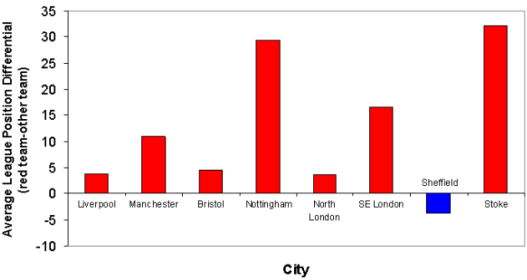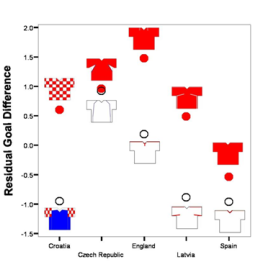red_advantage
Go to:
Return to:
Department of Anthropology
Durham University
Dawson Building
South Road
Durham DH1 3LE
UK
Tel: +44 (0) 191 334 1601
Fax: +44 (0) 191 334 1614
[email protected]
Last updated
15th January 2021

“Our game against Anderlecht at Anfield was a night of milestones. We wore the all red strip
for the first time. Christ, the players looked like giants. And we played like giants.“
Bill Shankly (1964) Manger, Liverpool F.C.
Darwin (1876) first noticed that primate males use colouration for attracting females and displaying dominance and subsequent studies have provided support for the significance of red. The intensity of red colouration in rhesus macaques and mandrills offers cues to male quality and status, but it is in male-male competition that the role of red is most pronounced. In mandrills, male red colouration on rump, face and genitalia depends on their testosterone-levels and male mandrills assess a rival’s fighting ability and dominance rank based on their brightness of the rival’s red colouration. In essense, the red colouration is a badge of status in primates, and in fact red colouration is associated with dominance and aggression in a wide range of taxa.
In humans, skin redness is not such a pronounced signal, but males tend to be redder than females and facial redness does correlate with testosterone levels and so may indicate high status and thus dominance. Redness due to oxygenated (redder) blood is a signal of increased aerobic fitness and humans interpret skin blood colouration as an honest cue to underlying health and a “ruddy” face is often associated with healthiness. Red skin colouration is also associated with anger and dominance.
For both humans and non-human species, therefore, there is evidence that red colouration signals both biological traits (health, testosterone and dominance) and emotional states (anger/arousal). It is also known that in animals, artificial colours can exploit innate responses to natural stimuli. We thus hypothesised that a similar response could exist in humans with artificial clothing colour exploiting the evolutionary associations between red and diminance. Human sporting competition provides the perfect test arena for this idea.
Our first evidence that colour might influence the outcome of sporting events was based on an analysis of four combat sports (boxing, taekwondo, freestyle wrestling and Graeco-Roman wrestling) at the 2004 Olympic Games in Athens, Greece (Hill and Barton, 2005). During this competition, red or blue uniforms were randomly assigned to competitors, providing a natural experiment. If colour had no effect on outcomes, an equal number of red and blue winners would be anticipated. Instead, Hill and Barton (2005) found that wearing red was associated with a significantly increased probability of winning with 55% of all bouts won by competitors in red (see below). Wearing red appeared to tip the balance between winning and losing in close contests; when competitors were closely matched over 60% of bouts had red winners, but in more asymmetric encounters (often knowckous) the colours were evenly matched. Interestingly, no such winning bias due to colour effects has been found in studies of judo contests where opponents are dressed in either blue or white. This suggests that while factors such as skill and ability will inevitably have the greatest say in determining sporting outcomes, the subtle effects of red colouration may decide contests where competitors are evenly matched.
Recently, a series of studies have provided support for the role of colour in determining sporting outcomes. A review of English football found an association between teams wearing red shirts and long-term success (Attrill et al. 2008). Since the Second World War, red teams have provided more champions and averaged higher finishing league positions than teams in other colours. Most significantly, within cities with more than one team, red teams have significantly outperformed their non-red neighbours over the 55 year period (see below). On a smaller scale, teams at the Euro 2004 appeared to have significantly better results when they were playing in their red shirts (see below). More recently, other researchers have found that penalty takers were the least successful when facing a goalkeeper wearing red, and penalty takers in red shirts are perceived to possess character traits such as confidence, assertiveness and composure to a greater extent than those in white shirts. Shirt colours also appear to influence the perceptions of referees (see video clip), and there is a growing body of evidence that “seeing red” is a particular distractor for men in competitive situations. Collectively these results suggest that the colour red may play a significant role in deciding sporting contests, although these relationships may be confined to male competitors. Nevertheless, one repercussion of these findings is that colour represents a significant obstacle to ensuring a level playing field in sport and suggests that governing bodies should play close attention to the colour of sporting attire.


minus the average position of the other team within the city. Positive values show a higher average position for the red team. (Attrill et al., 2008)

Recently we took part in a BBC Horizon programme exploring the importance and significance of colour. The programme explores some of our earlier research, starting with our original paper based on the Athens Olympics, and the footage includes some sequences with the Durham University Tae Kwon-Do Club. Since our original research there has been a growing body of evidence to show the significance of red on the perceivers (opponents, refererees and experimental subjects!) but the effect of wearing red on the wearer has remained comparatively unexplored. Nevertheless, we had hypothesised that impact of colour might operate through hormonal influences such that wearing red may, for example, elevate testosterone levels. In collaboration with Dr Iain Greenless (University of Chichester), Horizon gave us the opportunity to conduct a pilot study based on a penalty-taking competition, building on Iain’s earlier work in this area. At the same time we were able to collect and analyse the hormonal profiles of the participants in collaboration with the Durham Endocrinology & Ecology Laboratory. We are only now starting to analyse the hormonal data properly, but there is a tentative suggestion (nothing more than that, despite what the programme may suggest!!) that wearing red does have an influence on hormonal profiles (potentially cortsiol). Once we have the full results properly analysed we hope to have a manscipt submitted and available from here very soon!
Publications:
Wiedemann, D., Burt, D.M. Hill, R.A. & Barton, R.A. (2015) Red clothing increases perceived dominance, aggression and anger. Biology Letters. 11:20150166 (pdf)
Wiedemann, D., Barton, R.A. & Hill, R.A. (2012) Evolutionary approaches to sport. In: Roberts, S.C. (ed.) Applied Evolutionary Psychology. Oxford University Press, Oxford.
Attrill, M.J., Gresty, K.A., Hill, R.A. & Barton, R.A. (2008) Red shirt colour is associated with long-term team success in English football. Journal of Sports Science, 26: 577-582 (pdf)
Little, A.C & Hill, R.A. (2007) Attribution to red suggests special role in dominance signalling. Journal of Cultural and Evolutionary Psychology, 5: 87–94 (pdf)
Barton, R.A. & Hill, R.A. (2005) Sporting contests: Seeing red? Putting sportswear in context (reply). Nature, 437: E10-E11 (pdf)
Hill, R.A. & Barton, R.A. (2005) Red enhances human performance in contests. Nature 435: 293 (pdf) Supplementary methods (pdf); supplementary analyses (pdf); supplementary data (xls)
People:
Dr Russell Hill – Durham University (email)
Professor Rob Barton – Durham University (link) (email)
Diana Wiedemann – Durham University (link)

